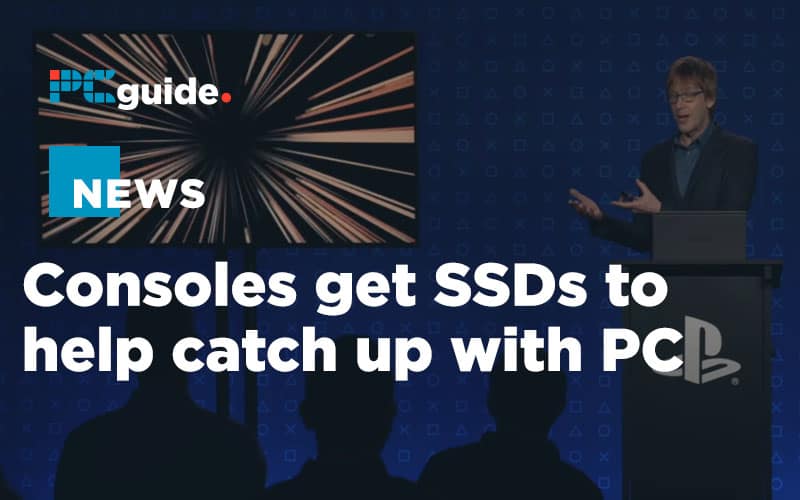
Sony has started lifting the curtain on some of the in-depth technical details that are going into making their upcoming fifth Playstation console, conveniently named Playstation 5. There’s lots of interesting detail laid out in this technical briefing from Sony, although the tone is a little strange given it was promoted by Sony across their consumer channels, but it’s very clearly an industry-focussed presentation. It was initially intended to be delivered at Game Developer Conference, to an audience of game developers and game industry professionals, but given the excitement surrounding any news about upcoming consoles, it was bound to attract attention from players too.
There’s lots of nitty-gritty detail, and I was just about managing to keep up with everything, but when it got time to discuss different compression formats, they started to lose me.
But one undeniably interesting element is Sony’s big bet on solid-state drive storage for their new console. Their new NVMe based SSD solution is going to offer bandwidth of upward of 5GB/s. This is not only a generation leap from the PS4’s HDD storage, but also way faster than anything else currently on the market, where consumer NVMe drives currently cap out at around 3.5GB/s, with many being slower still. This results in being able to load 2GB of data 0.27 seconds, whereas on PS4 it would load 1GB in 2 seconds. A massive jump in load speed.

Microsoft similarly has shifted from HDD for their new console, offering an NVMe SSD that offers speeds of around 2.5GB/s. A big jump up from the storage used in Xbox One consoles, but not quite as blistering fast as Sony’s PS5 drive.
Some of this might seem old hat to many PC users since many of us have been using some form of SSD in our systems for a decade or more, but this sea change in the console space has plenty of scope to impact how games are made across the industry, and so have a knock-on effect for PC users.
What are the benefits of an SSD for gaming?
Discussed somewhat in Sony’s presentation are the different ways that games can be made when being designed to run on fast SSDs. Many aspects of games we play today are built to run fine on a range of drive speeds, whether that’s cross-platform games that are going to be released on existing consoles, or PC games designed to run across a wide range of computers, including mid/low-end systems without an SSD.
These games have compromises built in to accommodate for slower loading of data from slower drives, and many of these compromises will still be in place even for users who are running the game from an SSD. Things like: a hard limit on player speed; repeated assets in environments; and long empty corridors, staircases and elevator rides separating highly detailed locations. You can speed up the time spent on loading screens, and speed up loading of in-game assets with a faster drive. However, many compromises on fundamental aspects of game design will still be in place even when played on hardware that wouldn’t necessitate these compromises.
This is a classic example of the lowest common denominator hardware holding back more capable machines. Most games released today are targeting large numbers of players, which means making sure their game is available to users on platforms like current consoles and PCs outside of high-end systems. Despite SSD technology being fairly mature at this point, and commonplace in top-end gaming systems, it’s not particularly economically viable for publishers to design games to require these higher drive speeds.
However these new consoles from Sony and Microsoft will create a large pool of players gaming on faster SSDs, and over time we will see games that can economically justify targeting just systems with these faster drives, so dropping support for PS4, Xbox One, and older PCs with hard disk drives.
So what does this mean for PC users?
It’s likely that we’ll see a transition period, plenty of publishers will not be in any rush to cut off the large number of players on older systems. Microsoft themselves have said that their first-party games are going to be cross-gen games, so will be designed around releasing on Xbox One and their next-gen Xbox Series X, in addition to PC. Games like Halo Infinity and Hellblade 2 might have enhancements on Xbox Series X and PCs with solid-state drives, but the fundamental game technology base will be designed to at least function on older hard disk drives. Major publishers like Ubisoft, Activision and EA will probably want to target the mass market of legacy systems for some time, but once these new consoles have achieved widespread adoption, the business case for supporting those legacy systems will likely trail off, and we will begin to see games across consoles and PCs start to seriously take advantage of faster drives.
It’s not clear when this shift might start to happen, but perhaps in the near future, we’ll start seeing minimum requirements for games that specify the need for a solid-state drive, or perhaps with a minimum drive speed. These games could be filled with more detailed worlds, with more unique in-game assets on screen at a time, and far less padding and pacing limits needed to mask load times. We’ve seen significant jumps over time with iterative upgrades to different components; there was also the advent of discrete GPUs back in the day. Perhaps the next big leap for gaming hardware could be shifting more users over to solid-state drives, and then game developers building games that really start to take advantage of them.
If you’re interested in picking up an SSD for your PC, you can checkout our roundup of the best SSD drives for 2020 over here.
